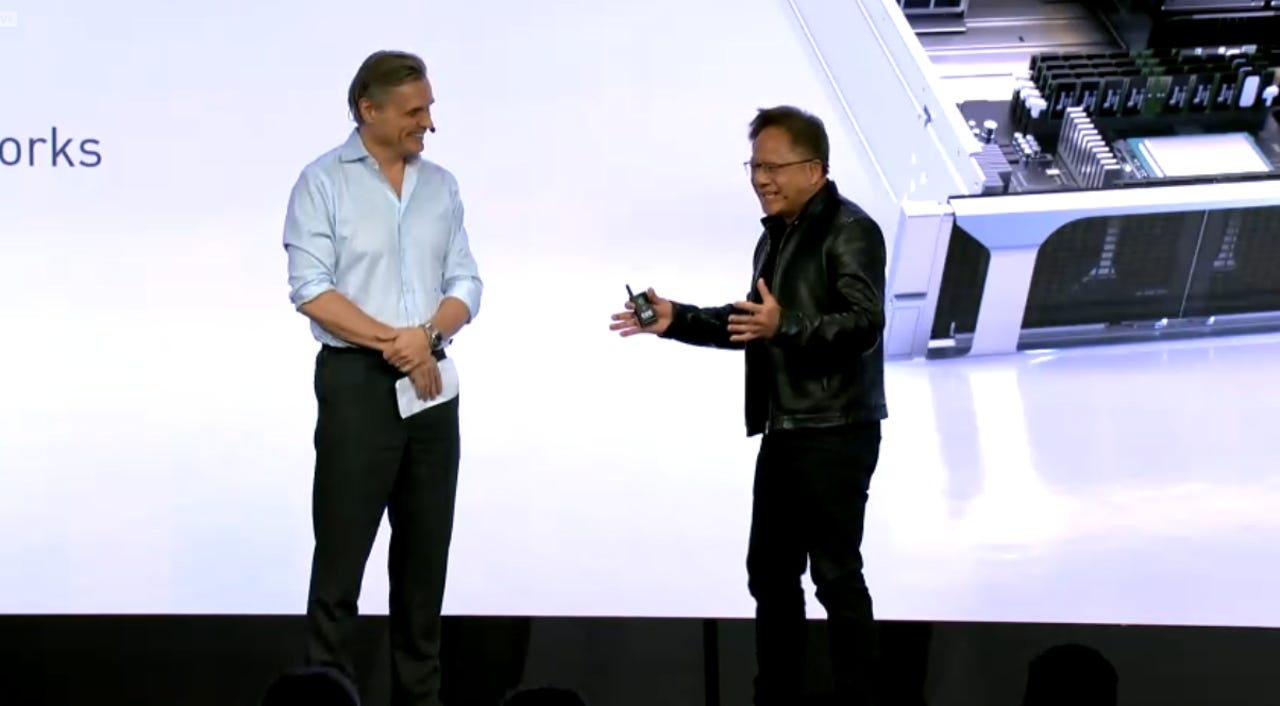Nvidia enters 5G with Ericsson, Red Hat, and Microsoft partnerships


Ericsson EVP and head of business area networks Fredrik Jejdling with Nvidia founder and CEO Jensen Huang during MWC Los Angeles
Nvidia has made a handful of announcements centred on its move into 5G, partnering with Ericsson, Red Hat, and Microsoft, with a spotlight on the telecommunications industry.
On its partnership with Swedish equipment manufacturer Ericsson, Nvidia founder and CEO Jensen Huang announced during his keynote at Mobile World Congress Los Angeles that the pair of companies had been "secretly" working together on technologies to allow telco operators to build high-performing, efficient, and completely virtualised 5G radio access networks (RAN).
According to Huang, it is the world's first software-defined 5G RAN.
The companies said these virtualised networks could enable a faster and more flexible introduction of new artificial intelligence (AI) and Internet of Things (IoT) services.
See also: How 5G can save lives by aiding first responders (CNET)
He said the ultimate goal of the pair of companies would be to commercialise virtualised RAN technologies to deliver radio networks to market for new services, such as augmented reality, virtual reality, and gaming, with greater flexibility and in less time.
"5G is set to turbocharge the intelligent edge revolution," he said. "Fusing 5G, supercomputing, and AI has enabled us to create a revolutionary communications platform supporting, someday, trillions of always-on, AI-enabled smart devices."
Joining Huang on stage during his keynote, Fredrik Jejdling, Ericsson EVP and head of business area networks, said 5G should not be used to just to connect people to each other.
"As an industry we've been struggling to find alternatives that are higher performing than our bespoke environment … we've now figured out, utilising GPUs, to build something flexible for our customers," Jejdling said. "Our collaboration is figuring out an efficient way of providing that."
Meanwhile, expanding its partnership with open source giant Red Hat, Nvidia announced it would now deliver high-performance, software-defined 5G wireless infrastructure, that would run on Red Hat OpenShift to the telco industry.
Work will initially focus on 5G RAN, and will be aimed at making AI-enabled applications more accessible at the telco edge, Huang said.
See also: Red Hat blends Kubernetes into Red Hat OpenStack Platform 14
A critical element enabling 5G providers to move to cloud-native infrastructure will be Nvidia Aerial, with Huang earlier announcing that the software developer kit would allow providers to build and deliver high-performance, software-defined 5G wireless RAN.
The Nvidia Aerial software developer kit announcement was made alongside the Nvidia EGX Edge Supercomputing Platform, which Huang said would allow organisations to harness rapidly streaming data from factory floors, manufacturing inspection lines, and city streets to securely deliver next-generation AI, IoT, and 5G-based services at scale, and with low latency.
"The industry is ramping 5G and the 'smart everything' revolution is beginning. Billions of sensors and devices will be sprinkled all over the world enabling new applications and services," Huang said. "We're working with Red Hat to build a cloud-native, massively scalable, high-performance GPU computing infrastructure for this new 5G world.
"Powered by the Nvidia EGX Edge Supercomputing Platform, a new wave of applications will emerge, just as with the smartphone revolution."
Nvidia and Microsoft have meanwhile announced a closer integration between Microsoft Azure and the Nvidia EGX platform, with the companies on Monday revealing that they are working together to advance edge-to-cloud AI computing capabilities.
"In order to use all of this sensory information … we're going to have to do this AI at the edge," Huang said during his keynote.
The companies will focus on intelligent edge computing, with the aim of helping industries better manage and gain insights from the data created by retail stores, warehouses, manufacturing facilities, connected buildings, and urban infrastructure, as some examples.
"The age of intelligent edge computing has arrived. The world's largest industries want to have AI computing at the edge, to extract insight from continuous streams of data, and to sense, reason and act at the point of action," Huang said.
"In time, this will be the largest-scale computing ever created, connecting trillions of smart sensors. Nvidia's and Microsoft's platforms dovetail to offer customers an end-to-end solution from edge to cloud."
"Together with Nvidia, we're bringing the power of Azure and Azure AI to the edge, enabling breakthrough experiences for our customers," Microsoft CEO Satya Nadella said in a statement. "In a world where computing is becoming embedded in every place and every thing, organisations require a distributed computing fabric that spans the cloud and edge."
RELATED COVERAGE
- 5G enthusiasm abounds from tech CEOs: Is it warranted?
- What is 5G? The definitive guide to next-generation wireless technology
- 5G Research Report 2019: The enterprise is eager to adopt, despite cost concerns and availability (TechRepublic)
- 5G network infrastructure market will be worth $4.2 billion next year
- How China, Brexit, and the US derailed global 5G wireless
- 5G is safe, just like 4G and 3G, says FCC